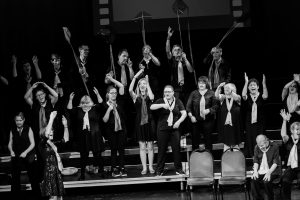 Capacity to sing a catchy tune
Capacity to sing a catchy tune
A song that lingers long after you’ve heard it is being used to help people understand and remember the principles of the Mental Capacity Act, says Alix Lewer
We all know that feeling when a fragment of song gets stuck in your head, sometimes for days – an ‘earworm’. So, if you want someone to remember your message, a musical earworm can be a useful ally.
The Include Choir – a groundbreaking, inclusive communication choir – is using the humble earworm to help people understand and remember the principles of the 2005 Mental Capacity Act (MCA). Arguably, everybody should know and care about the MCA – a law designed to ‘promote and safeguard decision-making’ (Social Care Institute of Excellence, 2016).
Any one of us might, one day, struggle to understand a choice or tell people what we want as a result of brain injury or a medical condition. This is a daily reality for many people with learning disabilities or autism. Despite the importance of the MCA, people are often unaware of it or of their rights protected by law.
The Include Choir is raising awareness about the MCA in an unusual way – through song. It is an inclusive choir for people with and without speaking or understanding disabilities. They perform locally (they are based in Redhill in Surrey) and further afield, with a broad repertoire including songs written collectively by the choir.
The Battle Hymn of the MCA is one of the choir’s most popular songs. ‘Before we started singing about it, I actually had no idea the Mental Capacity Act even existed,’ says Michael, an Include Choir member who has an autistic spectrum disorder. The song is frequently requested by healthcare providers and advocacy groups, who are keen to reinforce the principles of the act among their staff.
The choir has been invited to perform the song at the National Mental Capacity Action Day event for three years running, and never fails to elicit an encore (pictured). ‘The Include Choir, in one witty song, conveys the principles of the act better than I have seen done in any professional training session,’ says Alex Ruck Keene, barrister and author of Mental Capacity Law and Policy.
Songs and signs The Include Choir is doing more than singing about the MCA, however. By using Makaton signs, objects of reference and other inclusive communication techniques when they sing, the choir is demonstrating the fundamental (but often overlooked) principle of the act – the right to be supported to make your own decisions. Around 90% of people with learning disabilities have communication difficulties (Royal College of Speech and Language Therapy, 2013) and require support through inclusive communication (i.e. recognising and using all forms of communication, not just spoken or written words).
For those conducting mental capacity assessments, relatively simple things, such as providing a quiet room and using pictorial information, simple words or gestures can significantly reduce stress and improve the understanding of people with (and those without) learning disabilities (RCSLT, 2016). The use of inclusive communication tools and techniques is a fundamental stipulation of the MCA. Sadly, the verdict that someone lacks capacity is often recorded without any evidence that communication support has been provided, even though failing to make ‘reasonable adjustments’ or take ‘all practicable steps’ is unlawful.
By learning the Battle Hymn, Include choir members have been empowered to learn about their rights under the MCA. At rehearsals, the director uses Talking Mats (Murphy et al, 2013), a communication symbols tool, and a range of visual supports to maximise understanding of this complex legal topic. It is not just choristers who reap the benefits – more than 90% of accompanying support staff also report they understand the MCA better.
The Include Choir is now developing a training pack and downloadable resources so the song can be shared. Nowhere is the adage ‘get it right for the most vulnerable person and you get it right for everyone’ more relevant than in mental capacity assessment. The use of inclusive communication tools is fundamental to the MCA and it is in everyone’s best interests that poor practice is stamped out and education about rights is a top priority. With a song, signs – and sometimes a giant pair of sunglasses as a prop – the Include Choir has found a new way to educate, with people with learning disabilities front and centre.
See the Include Choir in action at www.youtube.com/c/theincludechoir/
The Include Choir plans to develop more choirs elsewhere.To find out about the choir or inclusive communication, visit: www.include.org or email: info@include.org.To donate, go to https://wonderful.org/charity/theincludeproject
Alix Lewer is director of Include.org and founder of the Include Choir
References Murphy J, Cameron L, Boa S (2013) Talking Mats: a Resource to Enhance Communication. www.talkingmats.com/projects/publications/ Royal College of Speech and Language Therapy (2013) Five good communication standards. London: RCST
Royal College of Speech and Language Therapy (2016) Inclusive Communication and the Role of Speech and Language Therapy. A position paper. London: RCST
Social Care Institute of Excellence (2016) Mental Capacity Act 2005 at a Glance. www.scie.org.uk/mca/introduction/mental-capacity-act-2005-at-a-glance

